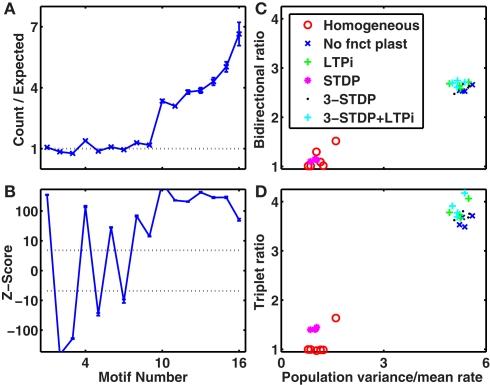Figure 12.
Clustering arises in random heterogeneous networks with raised spontaneous activity. (A,B) Excess of triplet motifs produced by structural plasticity in a default network with no functional plasticity and default, heterogeneous cells. (A) Ratio of counts for each motif (Figure 4A) to expected count. (B) Z-score (see Materials and Methods). (C) Ratio of bidirectional connections to expected number as a function of the variance of firing rates across cells of normalized by the population's mean firing rate (σ = 0.83, p = 1 × 10−4). (D) Ratio of numbers of triply connected motifs (numbered 10–16, Figure 4A) to expected number as a function of the variance of firing rates across cells of normalized by the population's mean firing rate (σ = 0.77, p = 8 × 10−4). (C,D) Networks labeled homogeneous had identical cells, but random connectivity, with variable base firing rates and plasticity mechanisms. Otherwise cells were heterogeneous (see Materials and Methods) with the indicated plasticity mechanisms. Results are based on all 320 excitatory, associative layer cells in a default network with no inputs, but with increased AMPA and GABA conductance noise (gnoise = 2.5 mS/s1/2) and in some examples, also reduced leak (to gL = 25 μS) to raise spontaneous activity. Networks were trained for 400 trials.

